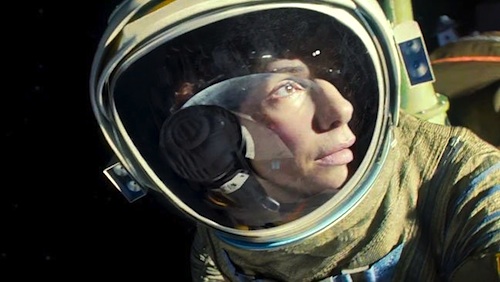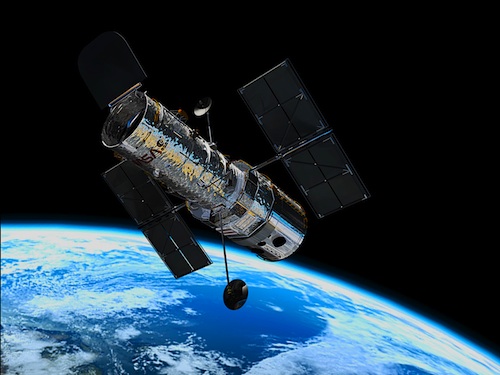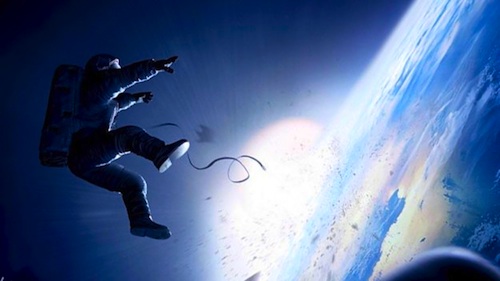
[Editor’s Note: the post below appears today on the front page of The Huffington Post.]
By Govindini Murty. Gravity is the number one movie in America for the second week in a row and has just passed the $200 million mark at the worldwide box office. It’s a triumph for star Sandra Bullock and for the cause of women in film – and it’s also a triumph for real science-based movies and 3D cinema technology.
Let’s start with the first point: it’s truly refreshing that Sandra Bullock’s character, Dr. Ryan Carter, is depicted in Gravity as an intelligent professional. I recently wrote that we needed more movies conveying ambitious visions for women – movies in which women have the opportunity to carry out significant deeds of intelligence, creativity, and heroism. Gravity is exactly this kind of film.
Gravity establishes from the beginning that Bullock’s character is in space because she has invented a groundbreaking medical imaging technology that NASA has decided to install in the Hubble Space Telescope for astronomical use. A medical doctor and not a trained astronaut, Dr. Carter’s skills are considered so integral to the mission that she has been given six months of astronaut training and has spent a full week in space in order to install the delicate technology in the multi-billion dollar Hubble.
As she carries out this mission and deals with its harrowing aftermath, Bullock’s character repeatedly displays a strength that is of the inner type. She has no superpowers or super-weapons: she is a real human being and when she is faced with extraordinary danger, she finds a stoic, inner self-sufficiency to survive. This is why the film has proven so inspiring to audiences.
Sci-fi has been dominated for some time by monsters, robots, clones, and caped superheroes – but these sorts of movies have underperformed lately and it seems that what audiences may be looking for now is not just surface spectacle (though there is impressive spectacle in Gravity), but inner character. The fact that Gravity has made over $200 million at the box office in under two weeks by devoting itself to the close examination of a female character’s emotional journey is a victory for strong women’s roles in science fiction.

Second, Gravity is a triumph for sci-fi movies based on real NASA science. NASA and JPL’s programs have proven highly popular with the public, yet Hollywood has made few real astronomy-based movies in recent years. Director Alfonso Cuarón has found a smart way to use NASA’s real space efforts (including the genuine collaboration between medical imaging and space science) as the catalyst for a poignant human story. He and his team have done this through realism: realism in depicting cutting-edge space technologies, realism in crafting detailed, pristine special effects, and most importantly, realism in the film’s characters.
I recently spoke about Gravity with NASA/ JPL Public Services Representative Marc Razze on the occasion of the Theodore von Kármán lecture at JPL. Razze told me that Gravity had proven popular with the scientists at JPL for capturing the emotions that they experience in their own research and missions to outer space. Razze noted: “From the folks I’ve talked to, including myself, we all enjoyed it …[in particular] the psychological component everybody seemed to really enjoy – it puts you in that place, where, if that happened, what would you do?”
And while Razze acknowledged the debate over the location of the Hubble and the space stations in the film – “all of those spacecraft don’t necessarily orbit in the same orbits” – he added that the movie did hew to realism by depicting the lack of sound in space. “I love the way they really made it silent, the way they emphasize that.”
Finally, the enormous success of Gravity shows that 3D cinema is here to stay. Over 80% of Gravity‘s box office on its first two weekends came from 3D screenings – an even higher percentage than Avatar. 3D is clearly the wave of the future and is being integrated into the next generation of consumer technologies and much more. News even came out recently that Disney researchers are developing a tactile 3D technology that will allow people to “feel” textures and shapes on flat screens.

The effort to imbue our art with greater three-dimensionality and depth has been an important human cultural drive. In Roman times, an early form of perspective was used on the wall paintings of Pompeii to draw the eye of the viewer into imaginary vistas of gardens and buildings to give a greater sense of space to a room. Three-dimensionality waned in the relatively flattened art of the Middle Ages, but it returned with Filippo Brunelleschi’s discovery of linear perspective in the Renaissance.
In the modern age, efforts toward three-dimensionality took a step forward in stereoscopic movie-viewing devices at the turn of the twentieth century, achieved an early peak in the 1950’s 3D boom, and are now here to stay with the mass adoption of 3D by the movie industry and by such leading directors as James Cameron, Ridley Scott, and Martin Scorsese. It seems likely that at some point movies will even become 3D holograms that surround us, perhaps even complete 3D virtual reality environments that audiences log into.
The goal of creating an immersive experience was a key reason Alfonso Cuarón and his cinematographer Emmanuel Lubezki chose to use 3D in Gravity. The film’s virtuoso seventeen-minute, 3D opening tracking shot was designed to draw the audience into a visceral, first-person experience of the story. As Cuarón describes it: “the camera is a third character that is the audience POV. So the audience is experiencing this journey together with the characters.”
This is why Gravity feels so real, for we experience reality as a seamless, continuous field all around us (only truncated by the blink of an eye, as Walter Murch has pointed out). We naturally see in 3D, as Ridley Scott said when promoting Prometheus: “When you put on those [3D] glasses, it reminds your brain of how you really see.” Gravity‘s use of long, continuous 3D shots and seamless digital melding of objective and subjective perspectives (such as when the camera travels from the outside of Dr. Carter’s helmet to inside it) highlights this sense of immersion and realism.

3D’s use of depth and perspective also serves a story purpose, highlighting the depth and perspective Sandra Bullock’s character gains through her experience in outer space. Female characters have traditionally flourished in art that requires depth. One thinks of the popularity of female central characters in 18th – 19th century novels that focus on inner character and inner life (as in Madame Bovary), rather than just the flatness of external appearance.
The use of depth and perspective also takes on metaphysical implications in Gravity. When Sandra Bullock’s character is sent careening into outer space without a tether, the 3D heightens the sense of the universe’s unfathomable distance and power. As Bullock’s tiny figure floats against the vast backdrop of the Milky Way Galaxy, a fundamental question rises up: we are aware of the universe, but is the universe aware of us?
Only the movies – in their full technological flowering – can so realistically depict the collision between the human and the cosmic, the individual and the eternal.
Posted on October 17th, 2013 at 4:56pm.